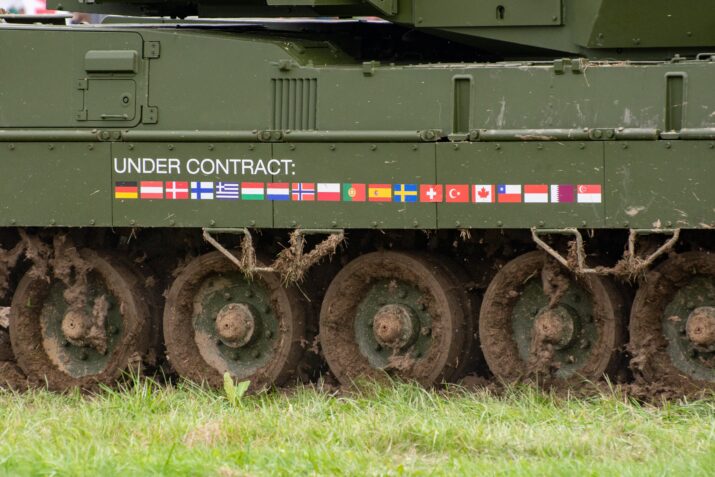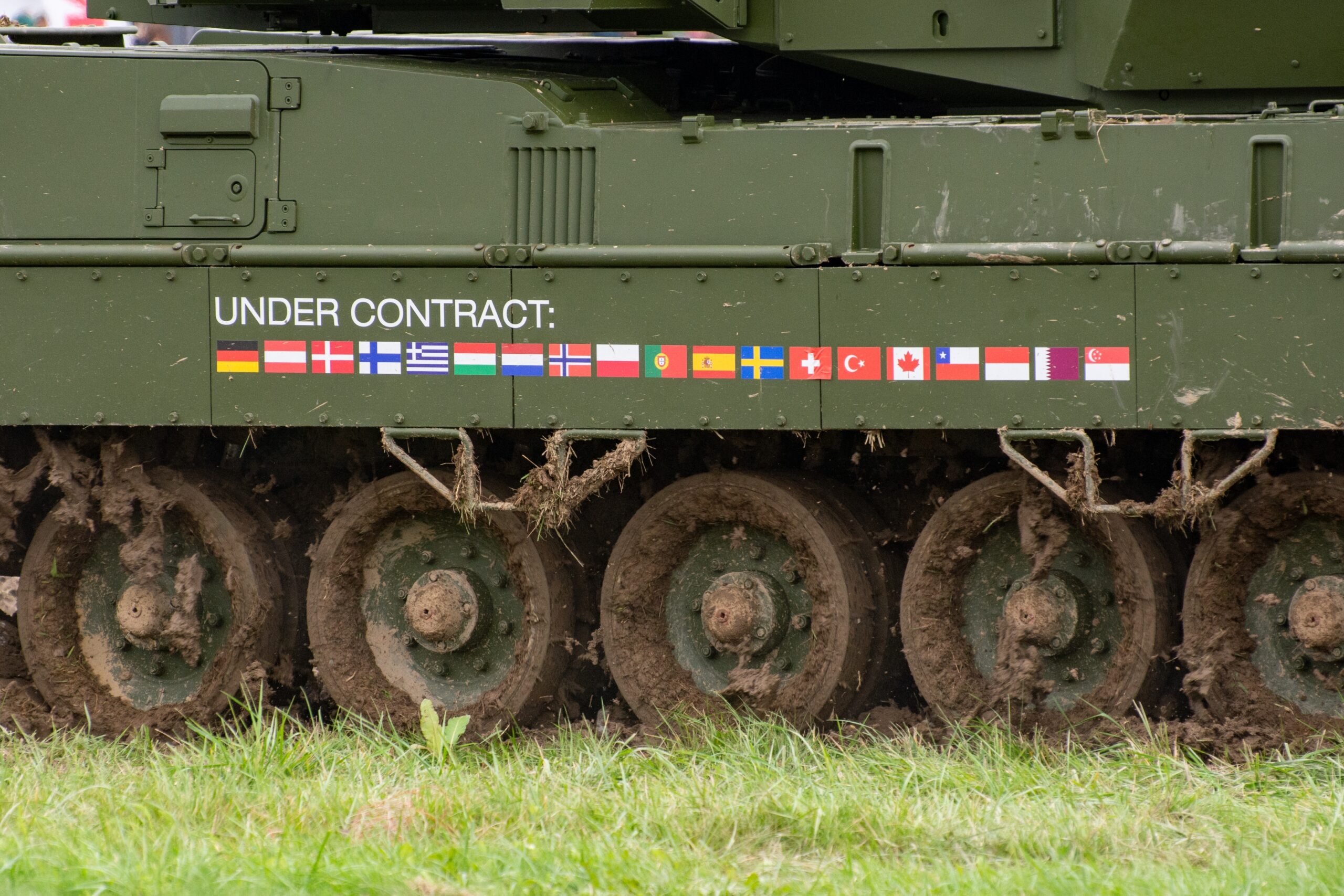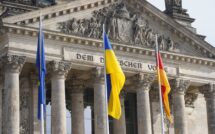

An introduction to our special feature, Europe and NATO Since Ukraine.
On February 24, 2022, the armed forces of the Russian Federation launched an invasion of the Republic of Ukraine. The ensuing war has profoundly changed not only the two countries directly involved but the politics and society of every European country and both the European Union (EU) and NATO. The conflict is the most significant war taking place in Europe—a continent where many thought of war as a relic of the past—since World War II. According to the United Nations High Commissioner on Refugees, over six million Ukrainians have already fled their country as refugees, virtually all going to European countries.[i] Moreover, Russia’s president, Vladimir Putin, has made clear that, after Ukraine, his government’s next target would be the West, that is, the EU and NATO.
In this special feature of EuropeNow, scholars of Europe from both sides of the Atlantic evaluate some of the impacts of the war on NATO, European institutions, and individual European countries. The crucial questions posed here involve the extent to which the immediate effects seen so far and the trends sparked by the war are likely to endure. In particular, will NATO continue to strengthen—as it did when Finland and Sweden joined the organization and NATO members increased their respective military budgets? Or will NATO weaken once again, as the war persists in a stalemate and populist and isolationist political parties assert themselves in member countries? Likewise, will the EU’s renewed unity persist, or will mostly obstacles lie ahead for the institution?
Unexpected immediate consequences of the war
Once a satellite of Russia, Ukraine has transitioned over the last thirty years to become an independent country, turning away from Russia and directing itself toward Europe instead—a process Marc Jansen takes into account in his article that explains the origins of the current war. Elaborating on this transition and drawing on his more than thirty years of experience as a specialist of Ukraine, Paul D’Anieri portrays how during the immediate post-Cold War era, Ukraine was positioned by European leaders at the periphery of Europe, even though Ukraine’s territory is greater than that of any European country and its population larger than that of any other Eastern European country. One reason for this neglect might be that during that time period, Europe was facing pressing issues such as the wars that emerged after the breakup of Yugoslavia and the integration of the northern bloc of Eastern European countries into the EU and NATO.
US leaders and NATO allies knew about Russia’s plans to invade and warned the Russian government that such action would prompt a massive response by NATO. Therefore, when Putin ordered the invasion anyway, it came as a surprise. Ukrainian leaders also knew about the looming attack, and Ukraine was prepared to fight back. In fact, a second surprise lies in how successful and vigorous the Ukrainian immediate military response was. The Ukrainian armed forces had been effectively rebuilt with the help of NATO countries after the 2014 Russian incursion into the Donbas and the annexation of Crimea. In his article about “Ukraine’s Shift From Periphery to Center,” Paul D’Anieri shows that when deciding to invade, Russia’s leaders failed to grasp the fundamental transformation of the Ukrainian economy and armed forces and Ukraine’s closer integration with Europe. Indeed, the Ukraine of 2022 was not the same Ukraine that Putin had contended with just eight years earlier. Today, although Russian forces hold approximately 18 percent of Ukrainian territory, one estimate, based on combined information from Western, Ukrainian, and Russian sources, puts Russian losses at over 200,000 killed and wounded and Ukraine’s losses at approximately 150,000.[ii] Since November 2022, the fronts in eastern and southern Ukraine have remained essentially static, with no significant gains for either side. The Russian army, despite losing a major part of its officer corps and having to rely increasingly on poorly-trained conscripts and prisoners, has fought better defensively than offensively. However, without control of the air and lacking an advantage in armor and artillery, Ukrainian forces have not broken through Russian defenses.
The third major unexpected consequence of the war has been the determination and unity shown by NATO, the EU, and individual countries in support of Ukraine. For Putin, the protests and limited sanctions over his annexation of Crimea and occupation of the Donbas in 2014 represented the limits of what Europe and the NATO alliance would impose. Since the 1990s, EU leaders had argued that Europeans should trust that “change through trade”—notably trade in Russian oil and natural gas—would keep Putin’s regime tied to the West. Likewise, Putin assumed that Europe’s dependence on Russian energy sources would deter any serious break in economic and financial relations. He was proven as disastrously wrong in this area as in his assumptions about Ukraine; and when European countries supplied Ukraine with military supplies and imposed sanctions on Russia in response to the latest invasion, Putin cut back on oil and gas supplies to Europe. However, despite dire predictions about Europeans freezing in their homes during the winter of 2022-23, Europe largely parried Russia’s cutoff. The EU gained valuable experience in coordinating large initiatives during the COVID-19 pandemic of 2020 and 2021; it partly built on these cooperative efforts in its collective response to the invasion. With Russian oil and natural gas no longer flowing to Europe, the entire energy sector on the continent was transformed. For example, new natural gas facilities had to be created to increase liquefied natural gas imports by sea. Before the war, the calls to build new, more energy-efficient facilities were met with counsels of caution over the expense. Under the pressure of war, construction accelerated beyond what had been believed possible. In ten months, Germany built liquefied natural gas terminals that had previously been estimated to take years to build. While natural gas from the US has been shipped to Europe in large quantities, Norway has become the largest natural gas supplier to the rest of Europe. Conservation, renewable sources, nuclear power, and coal have all undergone rapid reevaluation. During 2022 alone, European solar power generation rose by 24 percent. During 2022, wind and solar power generation in Europe for the first time surpassed fossil gas generation.[iii]
War-induced changes in NATO
Russia’s invasion has transformed NATO more than any other single event has since the Cold War ended. In 2018, Emmanuel Macron, France’s president, had declared that the organization was “brain dead” and lacked a clear purpose or mission. In the US, President Donald Trump mused publicly about the US withdrawing from NATO. But in reaction to the invasion of Ukraine, President Joe Biden and other NATO leaders have led a massive effort to supply Ukraine with weapons, intelligence, training, and financial aid. Moreover, Chancellor Olaf Scholz announced a historic Zeitenwende—or “turning point”—in Germany. Engaging in issues of stability and security in that country, William Gray highlights in his contribution to this feature that while reluctant to play a major role in the defense of Europe and in shaping European foreign policy in the post-World War II era, today’s Germany stands ready to help lead Europe in opposing Russian aggression. On paper at least, Germany is now committed to large-scale military expenditures, although its policies still betray tendencies to put economics before politics.
The changes in NATO have surpassed not only Putin’s assumptions but also those of many Western observers. The military supplies flowing into Ukraine have amounted to one of the largest cross-border inter-governmental transfers of any kind since World War II. Coordinating this vast movement of weapons and ammunition has required that members of the alliance work together more closely than ever before in order to ensure that factories, depots, and bases in the member countries are linked together. The entire logistical and strategic planning of NATO has been changed, first of all to support Ukraine and second to maintain a higher level of coordination to prevent Russia from endangering any of the allied states that border it. In fact, the most striking change in NATO has been the adhesion of previously neutral Finland and Sweden. Russia now has to face an additional 1,340 kilometer (833 miles) of border with NATO, while the Baltic Sea, one of Russia’s few outlets to ice-free ocean, is now effectively a NATO-controlled body of water. In addition, after years of complaining by the US that European partner nations do not contribute enough militarily, for the first time it appears that a significant number of countries will soon meet the goal of committing two percent of their GDP to military costs. Even though the US has thus far contributed the highest level of military aid to Ukraine, the EU and European NATO members have been the greatest supporters of Ukraine, contributing $91 billion in a little over a year and a half in the form of military, humanitarian, and refugee aid.[iv] Although the focus of attention on military matters has centered on NATO, the EU has begun to emerge as more of a military power in that arms production and shipments have had to be coordinated through EU connections. For Clara Portela, interviewed here about the main ways in which Europe has been transformed by the war, the EU has shown impressive nimbleness in its response, for example in its implementation of twelve rounds of sanctions against Russia and its use of the “European Peace Facility” fund to deliver arms to Ukraine, in what she sees as a bold reinterpretation of what that instrument was originally intended to cover.
Institutional breakdowns and consensus-making
NATO members’ solidarity has not been seamless. The US, Canada, Britain, Eastern Europe—with the exception of Hungary—and Scandinavian countries have all been strong supporters of Ukraine; and the war has irrevocably separated Eastern European countries from Russia. For example, Estonia, Latvia, and Lithuania—former members of the Soviet Union that gained independence in 1991—had close ties with Russia before the war, in part because they harbor sizeable Russian minorities. However, underlying tensions existed in their relationship with Russia, tensions that Jordan Kuck, in his assessment of the impact of the war in Ukraine on the Baltic states, depicts as finally resolved as a result of that war. While these states had remained vulnerable to Russia’s influence, today they see Russia as an enemy. By contrast, in France, President Macron was initially more willing than other European leaders to argue that lines of communication with Russia had to be kept open, based on the argument that, barring an outright military victory for Ukraine and the expulsion of Russian troops from Ukrainian soil, eventually a peace settlement would have to be reached. Germany has generally occupied a middle-of-the-road position, supportive of supplying arms to Ukraine but cautious about taking the lead in doing so and concerned that disengagement from Russia should not be total. Chancellor Scholz remains convinced that the de facto alliance between China—Germany’s greatest trading partner—and Russia should not undermine the all-important German-Chinese trading relationship. Other fissures within NATO persist, for example in the face of Turkey’s continued trading relations with Russia and Hungary’s close political ties with Russia, although neither of these two countries has blocked NATO from supporting Ukraine.
If NATO or the EU came to include Ukraine and Moldova—the latter being another former Soviet republic ready to divorce itself from alignment with Russia—difficult questions would emerge for both organizations. Like Portela, in evaluating the impact of the war on the Transatlantic relationship, Bram Boxhoorn contends that NATO and the EU have had a long history of trying to preserve their unity, which has meant that both organizations have proceeded cautiously when expanding further to the east. Neither NATO nor the EU has ever welcomed a nation bearing active territorial threats and engaged in on-going armed conflicts on its borders. In addition to the continuing disputes over migration and monetary policy within the EU, further enlargement to the east might be too steep a hill to climb in the near future. Moreover, standards of living being significantly lower in Ukraine than in other EU member states, the large population of Ukraine would entail major aid from the rest of the EU.
Changes in the EU
The conflict between Ukraine and Russia has become an existential challenge for the EU, leading some scholars to believe that “the path to the future of Europe hinges on the choices made about Ukraine” (D’Anieri in this feature). In the wake of Brexit and the continuing debates over financial integration and migration, the EU weathered fierce internal opposition from populists and nationalists on the eve of the Ukraine war. The war has indeed forced the EU to confront simultaneous energy, refugee, financial, and diplomatic crises. Yet the war has also starkly reinforced the difference between democratic, free-market Europe and an autocratic, oligarchic alternative exemplified by Russia. Even Giorgia Meloni—the first Italian prime minister to have been elected with the support of the far-right in the last eighty years—has been resolute in supporting Ukraine. Partly in reaction to the war, Europeans appear to identify more strongly than ever with the EU. In 2010, only half of Europeans thought that the EU benefitted their country, and 39 percent believed it did not. Today, supporters outnumber doubters almost three to one: 72 to 22 percent.[v]
As he explains the changing role of Central and East European countries in light of the war in Ukraine, in particular addressing the new lens through which they now view China (no longer seeing it as a reliable partner in a peaceful global order because of its support of Russia), Emilian Kavalski delves into how the war has also changed Europe’s relationships with the rest of the world. On the second anniversary of the beginning of the war, Europe’s support for Ukraine has increasingly separated it from much of the rest of the world. The 32 countries that abstained from voting for the UN resolution condemning Russia’s invasion include the two most populated countries in the world—China and India—which are also two of Europe’s most important trading partners. Both these countries have greatly supported Russia by buying the oil it no longer ships to Europe. China’s support has accelerated what EU President Ursula von der Leyen has called a policy of “de-risking” vis-à-vis China. In other words, Europe will maintain financial trade and diplomatic and international organizational ties with China but pull back or re-direct trade, investment, and technological involvement with that country, which might put Europe’s security at risk. With China largely supplanting Europe as Russia’s supplier of manufactured goods, the sanctions imposed on Russia have not isolated it so much as they have caused it to be integrated in a Chinese-led economic bloc. Russia is thus poised to be further estranged from Europe in the future, while Ukraine moves towards becoming Europe’s besieged frontier.
While the final outcome of the war in Ukraine is still unknown, the war has already transformed the EU, NATO, Europe’s relationship with the US, and the relations between Eastern and Western European countries. Some changes, such as increases in military expenditures and the absorption of Ukrainian refugees, may be temporary. Others, such as the estrangement from Russia and the reorientation of European energy imports away from Russia’s suppliers, are more likely to last. What remains unclear is whether the EU’s and NATO’s newfound resolve and unity will endure were Russia to win the war and control Ukraine once again. Given the profound transformations prompted by the war in Ukraine, it is all the more important for policymakers and scholars to probe deeply into how these changes are both the direct result of the war and the outgrowth of long-seeded trends that predate it.
Research
Commentary
- “Europe’s Watershed and Ukraine’s Shift From Periphery to Center” by Paul D’Anieri
- “Russia-Europe Relations Before the 2022 Invasion of Ukraine” by Marc Jansen
- “The Impact of the Ukraine War on the Transatlantic Relationship” by Bram Boxhoorn
- “An Assessment of the Impact of the War in Ukraine on the Baltic States” by Jordan T. Kuck
- “’Are You Paying Attention to Us Now?’ Recognizing the Centrality of Central and East European Countries” by Emilian Kavalski
Interviews
Book Reviews
Poetry
Fiction
Nonfiction
Editor’s Pick
Carl J. Strikwerda (PhD) has published three books and thirty articles on European and global history. A former historical consultant to the National World War One Museum, his research has been supported by the German Marshall Fund of the United States, and he has been a member of the Executive Committee of the Council for European Studies. His next book, The Origins of the Contemporary Global Order: From the Nineteenth Century to the Cold War will be published by Palgrave Macmillan in 2024.
Ruud van Dijk (PhD) is a senior lecturer in the history of international relations at the University of Amsterdam. He is the senior editor of the Encyclopedia of the Cold War (Routledge, 2008), currently being expanded and updated for inclusion in the Routledge Resources Online series. He has published on the history of the Euromissile crisis of the 1970s and 1980s and more recently has become interested in the so-called “missed opportunities” in the relations between Russia and the West in the 1990s.
[i] https://data.unhcr.org/en/situations/ukraine
[ii] Harvard Kennedy School Belfer Center for Science and International Affairs. “The Russia-Ukraine War Report Card, Feb. 6, 2024: Who’s Winning and Who’s Losing What?” https://www.russiamatters.org/news/russia-ukraine-war-report-card/russia-ukraine-war-report-card-feb-6-2024
[iii] https://www.greenbiz.com/article/wind-and-solar-power-generated-more-electricity-eu-last-year-gas-heres-how
[iv] https://www.eeas.europa.eu/delegations/united-states-america/eu-assistance-ukraine-us-dollars_en?s=253
[v] https://www.europarl.europa.eu/news/en/press-room/20231204IPR15637/survey-shows-europeans-value-eu-membership-and-interested-in-european-elections; https://europa.eu/eurobarometer/surveys/detail/917
Published on February 20, 2024.




